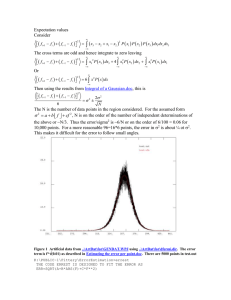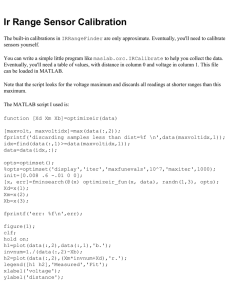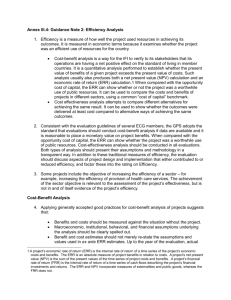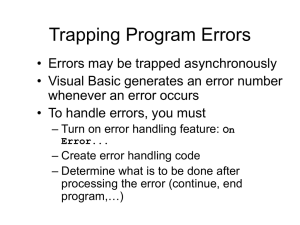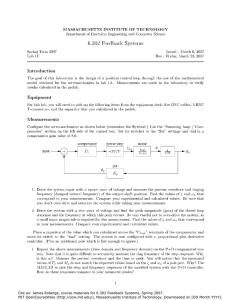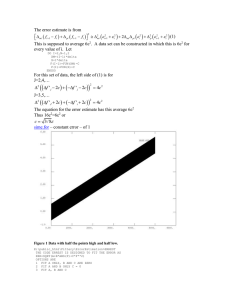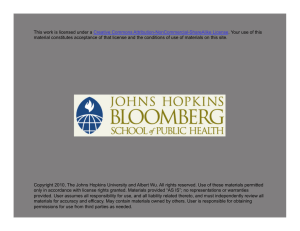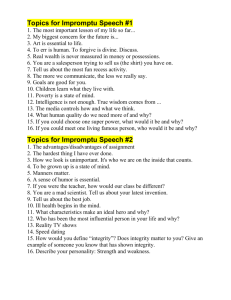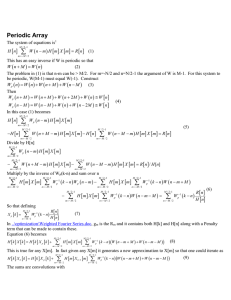67577 – Intro. to Machine Learning Fall semester, 2008/9 Lecturer: Amnon Shashua
advertisement
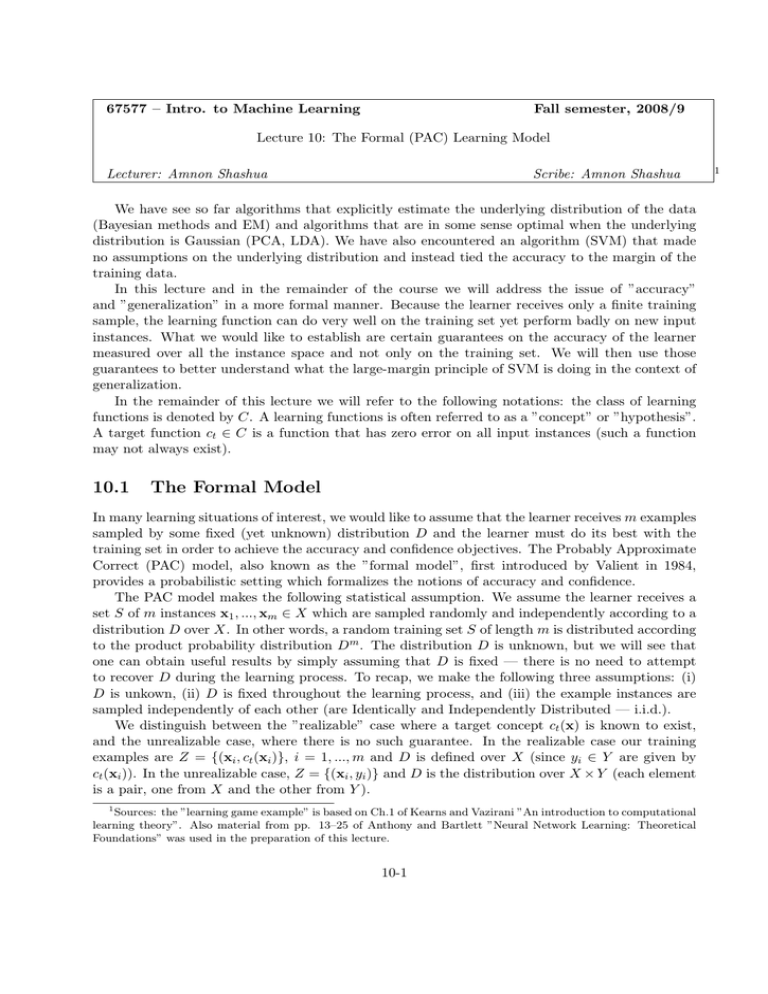
67577 – Intro. to Machine Learning
Fall semester, 2008/9
Lecture 10: The Formal (PAC) Learning Model
Lecturer: Amnon Shashua
Scribe: Amnon Shashua
We have see so far algorithms that explicitly estimate the underlying distribution of the data
(Bayesian methods and EM) and algorithms that are in some sense optimal when the underlying
distribution is Gaussian (PCA, LDA). We have also encountered an algorithm (SVM) that made
no assumptions on the underlying distribution and instead tied the accuracy to the margin of the
training data.
In this lecture and in the remainder of the course we will address the issue of ”accuracy”
and ”generalization” in a more formal manner. Because the learner receives only a finite training
sample, the learning function can do very well on the training set yet perform badly on new input
instances. What we would like to establish are certain guarantees on the accuracy of the learner
measured over all the instance space and not only on the training set. We will then use those
guarantees to better understand what the large-margin principle of SVM is doing in the context of
generalization.
In the remainder of this lecture we will refer to the following notations: the class of learning
functions is denoted by C. A learning functions is often referred to as a ”concept” or ”hypothesis”.
A target function ct ∈ C is a function that has zero error on all input instances (such a function
may not always exist).
10.1
The Formal Model
In many learning situations of interest, we would like to assume that the learner receives m examples
sampled by some fixed (yet unknown) distribution D and the learner must do its best with the
training set in order to achieve the accuracy and confidence objectives. The Probably Approximate
Correct (PAC) model, also known as the ”formal model”, first introduced by Valient in 1984,
provides a probabilistic setting which formalizes the notions of accuracy and confidence.
The PAC model makes the following statistical assumption. We assume the learner receives a
set S of m instances x1 , ..., xm ∈ X which are sampled randomly and independently according to a
distribution D over X. In other words, a random training set S of length m is distributed according
to the product probability distribution Dm . The distribution D is unknown, but we will see that
one can obtain useful results by simply assuming that D is fixed — there is no need to attempt
to recover D during the learning process. To recap, we make the following three assumptions: (i)
D is unkown, (ii) D is fixed throughout the learning process, and (iii) the example instances are
sampled independently of each other (are Identically and Independently Distributed — i.i.d.).
We distinguish between the ”realizable” case where a target concept ct (x) is known to exist,
and the unrealizable case, where there is no such guarantee. In the realizable case our training
examples are Z = {(xi , ct (xi )}, i = 1, ..., m and D is defined over X (since yi ∈ Y are given by
ct (xi )). In the unrealizable case, Z = {(xi , yi )} and D is the distribution over X × Y (each element
is a pair, one from X and the other from Y ).
1
Sources: the ”learning game example” is based on Ch.1 of Kearns and Vazirani ”An introduction to computational
learning theory”. Also material from pp. 13–25 of Anthony and Bartlett ”Neural Network Learning: Theoretical
Foundations” was used in the preparation of this lecture.
10-1
1
Lecture 10: The Formal (PAC) Learning Model
10-2
We next define what is meant by the error induced by a concept function h(x). In the realizable
case, given a function h ∈ C, the error of h is defined with respect to the distribution D:
err(h) = probD [x : ct (x) 6= h(x)] =
Z
x∈X
ind(ct (x) 6= h(x))D(x)dx
where ind(F ) is an indication function which returns ’1’ if the proposition F is true and ’0’ otherwise. The function err(h) is the probability that an instance x sampled according to D will be
labeled incorrectly by h(x). Let > 0 be a parameter given to the learner specifying the ”accuracy”
of the learning process, i.e. we would like to achieve err(h) ≤ . Note that err(ct ) = 0.
In addition, we define a ”confidence” parameter δ > 0, also given to the learner, which defines
the probability that err(h) > , namely,
prob[err(h) > ] < δ,
or equivalently:
prob[err(h) ≤ ] ≥ 1 − δ.
In other words, the learner is supposed to meet some accuracy criteria but is allowed to deviate
from it by some small probability. Finally, the learning algorithm is supposed to be ”efficient” if
the running time is polynomial in 1/, ln(1/δ), n and the size of the concept target function ct ()
(measured by the number of bits necessary for describing it, for example).
We will say that an algorithm L learns a concept family C in the formal sense (PAC learnable)
if for any ct ∈ C and for every distribution D on the instance space X, the algorithm L generates
efficiently a concept function h ∈ C such that the probability that err(h) ≤ is at least 1 − δ.
The inclusion of the confidence value δ could seem at first unnatural. What we desire from the
learner is to demonstrate a consistent performance regardless of the training sample Z. In other
words, it is not enough that the learner produces a hypothesis h whose accuracy is above threshold,
i.e., err(h) ≤ , for some training sample Z. We would like the accuracy performance to hold under
all training samples (sampled from the distribution Dm ) — since this requirement could be too
difficult to satisfy, the formal model allows for some ”failures”, i.e, situations where err(h) > , for
some training samples Z, as long as those failures are rare and the frequency of their occurrence is
controlled (the parameter δ) and can be as small as we like.
In the unrealizable case, there may be no function h ∈ C for which err(h) = 0, thus we need to
define what we mean by the best a learning algorithm can achieve:
Opt(C) = min err(h),
h∈C
which is the best that can be done on the concept class C using functions that map between X
and Y . Given the desired accuracy and confidence δ values the learner seeks a hypothesis h ∈ C
such that:
prob[err(h) ≤ Opt(C) + ] ≥ 1 − δ.
We are ready now to formalize the discussion above and introduce the definition of the formal
learning model (Anthony-Bartlett, pp. 16):
Definition 1 (Formal Model) Let C be the concept class of functions that map from a set X to
Y . A learning algorithm L is a function:
L:
∞
[
m=1
{(xi , yi )}m
i=1 → C
Lecture 10: The Formal (PAC) Learning Model
10-3
from the set of all training examples to C with the following property: given any , δ ∈ (0, 1) there
is an integer m0 (, δ) such that if m ≥ m0 then, for any probability distribution D on X × Y , if
Z is a training set of length m drawn randomly according to the product probability distribution
Dm , then with probability of at least 1 − δ the hypothesis h = L(Z) ∈ C output by L is such that
err(h) ≤ Opt(C) + . We say that C is learnable (or PAC learnable) if there is a learning algorithm
for C.
There are few points to emphasize. The sample size m0 (, δ) is a sufficient sample size for PAC
learning C by L and is allowed to vary with , δ. Decreasing the value of either or δ makes the
learning problem more difficult and in turn a larger sample size is required. Note however that
m0 (, δ) does not depend on the distribution D! that is, a sufficient sample size can be given that
will work for any distribution D — provided that D is fixed throughout the learning experience
(both training and later for testing). This point is a crucial property of the formal model because
if the sufficient sample size is allowed to vary with the distribution D then not only we would need
to have some information about the distribution in order to set the sample complexity bounds,
but also an adversary (supplying the training set) could control the rate of convergence of L to a
solution (even if that solution can be proven to be optimal) and make it arbitrarily slow by suitable
choice of D.
What makes the formal model work in a distribution-invariant manner is that it critically
depends on the fact that in many interesting learning scenarios the concept class C is not too
complex. For example, we will show later in the lecture that any finite concept class |C| < ∞ is
learnable, and the sample complexity (in the realizable case) is
m≥
1 |C|
ln
.
δ
In lectures 4,5 we will look into concept classes of infinite size and show that despite the fact that
the class is infinite it still can be of low complexity!
Before we illustrate the concepts above with an example, there is another useful measure which
is the empirical error (also known as the sample error) err(h)
ˆ
which is defined as the proportion
of examples from Z on which h made a mistake:
err(h)
ˆ
=
1
|{i : h(xi ) 6= ct (xi )}|
m
(replace ct (xi ) with yi for the unrealizable case). The situation of bounding the true error err(h)
by minimizing the sample error err(h)
ˆ
is very convenient — we will get to that later.
10.2
The Rectangle Learning Problem
As an illustration of learnability we will consider the problem (introduced in Kearns-Vazirani) of
learning an axes-aligned rectangle from positive and negative examples. We will show that the
problem is PAC-learnable and find out m0 (, δ).
In the rectangle learning game we are given a training set consisting of points in the 2D plane
with a positive ’+’ or negative ’-’ label. The positive examples are sampled inside the target
rectangle (parallel to the main axes) R and the negative examples are sampled outside of R. Given
m examples sampled i.i.d according to some distribution D the learner is supposed to generate an
approximate rectangle R0 which is consistent with the training set (we are assuming that R exists)
and which satisfies the accuracy and confidence constraints.
Lecture 10: The Formal (PAC) Learning Model
10-4
We first need to decide on a learning strategy. Since the solution R0 is not uniquely defined
given any training set Z, we need to add further constraints to guarantee a unique solution. We will
choose R0 as the axes-aligned concept which gives the tightest fit to the positive examples, i.e., the
smallest area axes-aligned rectangle which contains the positive examples. If no positive examples
are given then R0 = ∅. We can also assume that Z contains at least three non-collinear positive
examples in order to avoid complications associated with infinitesimal area rectangles. Note that
we could have chosen other strategies, such as the middle ground between the tightest fit to the
positive examples and the tightest fit (from below) to the negative examples, and so forth. Defining
a strategy is necessary for the analysis below — the type of strategy is not critical though.
We next define the error err(R0 ) on the concept R0 generated by our learning strategy. We
first note that with the strategy defined above we always have R0 ⊂ R since R0 is the tightest fit
solution which is consistent with the sample data (there could be a positive example outside of R0
which is not in the training set). We will define the ”weight” w(E) of a region E in the plane as
Z
w(E) =
x∈E
D(x)dx,
i.e., the probability that a random point sampled according to the distribution D will fall into the
region. Therefore, the error associated with the concept R0 is
err(R0 ) = w(R − R0 )
and we wish to bound the error w(R − R0 ) ≤ with probability of at least 1 − δ after seeing m
examples.
We will divide the region R − R0 into four strips T10 , ..., T40 (see Fig.10.1) which overlap at the
corners. We will estimate prob(w(Ti0 ) ≥ 4 ) noting that the overlaps between the regions makes
our estimates more pessimistic than they truly are (since we are counting the overlapping regions
twice) thus making us lean towards the conservative side in our estimations.
Consider the upper strip T10 . If w(T10 ≤ 4 ) then we are done. We are however interested in
quantifying the probability that this is not the case. Assume w(T10 ) > 4 and define a strip T1 which
starts from the upper axis of R and stretches to the extent such that w(T1 ) = 4 . Clearly T1 ⊂ T10 .
We have that w(T10 ) > 4 iff T1 ⊂ T10 . Furthermore:
Claim 1 T1 ⊂ T10 iff x1 , ..., xm 6∈ T1 .
Proof: If xi ∈ T1 the the label must be positive since T1 ⊂ R. But if the label is positive then
given our learning strategy of fitting the tightest rectangle over the positive examples, then xi ∈ R0 .
Since T1 6⊂ R0 it follows that xi 6∈ T1 .
We have therefore that w(T10 > 4 ) iff no point in T1 appears in the sample S = {x1 , ..., xm }
(otherwise T1 intersects with R0 and thus T10 ⊂ T1 ). The probability that a point sampled according
to the distribution D will fall outside of T1 is 1 − 4 . Given the independence assumption (examples
are drawn i.i.d.), we have:
prob(x1 , ..., xm 6∈ T1 ) = prob(w(T10 > )) = (1 − )m .
4
4
Repeating the same analysis to regions T20 , T30 , T40 and using the union bound P (A ∪ B) ≤ P (A) +
P (B) we come to the conclusion that the probability that any of the four strips of R − R0 has
weight greater that /4 is at most 4(1 − 4 )m . In other words,
prob(err(L0 ) ≥ ) ≤ 4((1 − )m ≤ δ.
4
Lecture 10: The Formal (PAC) Learning Model
10-5
Figure 10.1: Given the tightest-fit to positive examples strategy we have that R0 ⊂ R. The strip
T1 has weight /4 and the strip T10 is defined as the upper strip covering the area between R and
R0 .
We can make the expression more convenient for manipulation by using the inequality e−x ≥ 1 − x
(recall that 1 + (1/n))n < e from which it follows that (1 + z)1/z < e and by taking the power of
rz where r ≥ 0 we obtain (1 + z)r < erz then set r = 1, z = −x):
m
4(1 − )m ≤ 4e− 4 ≤ δ,
4
from which we obtain the bound:
4 4
ln .
δ
To conclude, assuming that the learner adopts the tightest-fit to positive examples strategy and
is given at least m0 = 4 ln 4δ training examples in order to find the axes-aligned rectangle R0 , we
can assert that with probability 1 − δ the error associated with R0 (i.e., the probability that an
(m + 1)’th point will be classified incorrectly) is at most .
We can see form the analysis above that indeed it applies to any distribution D where the only
assumption we had to make is the independence of the draw. Also, the sample size m behaves well
in the sense that if one desires a higher level of accuracy (smaller ) or a higher level of confidence
(smaller δ) then the sample size grows accordingly. The growth of m is linear in 1/ and linear in
ln(1/δ).
m≥
10.3
Learnability of Finite Concept Classes
In the previous section we illustrated the concept of learnability with a particular simple example.
We will now focus on applying the learnability model to a more general family of learning examples.
We will consider the family of all learning problems over finite concept classes |C| < ∞. For
example, the conjunction learning problem (over boolean formulas) which we looked at in Lecture
1 with n literals contains only 3n hypotheses because each variable can appear in the conjunction
or not and if appears it could be negated or not. We have shown that n is the lower bound on
the number of mistakes on the worst case analysis any on-line algorithm can achieve. With the
definitions we have above on the formal model of learnability we can perform accuracy and sample
Lecture 10: The Formal (PAC) Learning Model
10-6
complexity analysis that will apply to any learning problem over finite concept classes. This was
first introduced by Valiant in 1984.
In the realizable case over |C| < ∞, we will show that any algorithm L which returns a
hypothesis h ∈ C which is consistent with the training set Z is a learning algorithm for C. In other
words, any finite concept class is learnable and the learning algorithms simply need to generate
consistent hypotheses. The sample complexity m0 associated with the choice of and δ can be
shown as equal to: 1 ln |C|
δ .
In the unrealizable case, any algorithm L that generates a hypothesis h ∈ C that minimizes
the empirical error (the error obtained on Z) is a learning algorithm for C. The sample complexity
can be shown as equal to: 22 ln 2|C|
δ . We will derive these two cases below.
10.3.1
The Realizable Case
Let h ∈ C be some consistent hypothesis with the training set Z (we know that such a hypothesis
exists, in particular h = ct the target concept used for generating Z) and suppose that
err(h) = prob[x ∼ D : h(x) 6= ct (x)] > .
Then, the probability (with respect to the product distribution Dm ) that h agrees with ct on a
random sample of length m is at most (1 − )m . Using the inequality we saw before e−x ≥ 1 − x
we have:
prob[err(h) > && h(xi ) = ct (xi ), i = 1, ..., m] ≤ (1 − )m < e−m .
We wish to bound the error uniformly, i.e., that err(h) ≤ for all concepts h ∈ C. This requires
the evaluation of:
prob[max{err(h) > } && h(xi ) = ct (xi ), i = 1, ..., m].
h∈C
There at most |C| such functions h, therefore using the Union-Bound the probability that some
function in C has error larger than and is consistent with ct on a random sample of length m is
at most |C|e−m :
prob[∃h : err(h) > && h(xi ) = ct (xi ), i = 1, ..., m]
≤
X
prob[h(xi ) = ct (xi ), i = 1, ..., m]
h:err(h)>
≤ |h : err(h) > |e−m
≤ |C|e−m
For any positive δ, this probability is less than δ provided:
m≥
1 |C|
ln
.
δ
This derivation can be summarized in the following theorem (Anthony-Bartlett, pp. 25):
Theorem 1 Let C be a finite set of functions from X to Y . Let L be an algorithm such that for
any m and for any ct ∈ C, if Z is a training sample {(xi , ct (xi ))}, i = 1, ..., m, then the hypothesis
h = L(Z) satisfies h(xi ) = ct (xi ). Then L is a learning algorithm for C in the realizable case with
sample complexity
1 |C|
m0 = ln
.
δ
Lecture 10: The Formal (PAC) Learning Model
10.3.2
10-7
The Unrealizable Case
In the realizable case an algorithm simply needs to generate a consistent hypothesize to be considered a learning algorithm in the formal sense. In the unrealizable situation (a target function ct
might not exist) an algorithm which minimizes the empirical error, i.e., an algorithm L generates
h = L(Z) having minimal sample error:
err(L(Z))
ˆ
= min err(h)
ˆ
h∈C
is a learning algorithm for C (assuming finite |C|). This is a particularly useful property given that
the true errors of the functions in C are unknown. It seems natural to use the sample errors err(h)
ˆ
as estimates to the performance of L.
The fact that given a large enough sample (training set Z) then the sample error err(h)
ˆ
becomes
close to the true error err(h) is somewhat of a restatement of the ”law of large numbers” of
probability theory. For example, if we toss a coin many times then the relative frequency of ’heads’
approaches the true probability of ’head’ at a rate determined by the law of large numbers. We can
bound the probability that the difference between the empirical error and the true error of some h
exceeds using Hoeffding’s inequality:
Claim 2 Let h be some function from X to Y = {0, 1}. Then
2 m)
prob[|err(h)
ˆ
− err(h)| ≥ ] ≤ 2e(−2
,
for any probability distribution D, any > 0 and any positive integer m.
Proof: This is a straightforward application of Hoeffding’s inequality to Bernoulli variables.
Hoeffding’s inequality says: Let X be a set, D a probability distribution on X, and f1 , ..., fm
real-valued functions fi : X → [ai , bi ] from X to an interval on the real line (ai < bi ). Then,
22 m2
m
−P
1 X
(b −ai )2
i i
prob |
fi (xi ) − Ex∼D [f (x)]| ≥ ≤ 2e
m i=1
"
where
#
m
1 X
Ex∼D [f (x)] =
m i=1
(10.1)
Z
fi (x)D(x)dx.
In our case fi (xi ) = 1 iff h(xi ) 6= yi and ai = 0, bi = 1. Therefore (1/m) i fi (xi ) = err(h)
ˆ
and
err(h) = Ex∼D [f (x)].
The Hoeffding bound almost does what we need, but not quite so. What we have is that for
any given hypothesis h ∈ C, the empirical error is close to the true error with high probability.
Recall that our goal is to minimize err(h) over all possible h ∈ C but we can access only err(h).
ˆ
If we can guarantee that the two are close to each other for every h ∈ C, then minimizing err(h)
ˆ
over all h ∈ C will approximately minimize err(h). Put formally, in order to ensure that L learns
the class C, we must show that
P
prob max |err(h)
ˆ
− err(h)| < > 1 − δ
h∈C
In other words, we need to show that the empirical errors converge (at high probability) to the true
errors uniformly over C as m → ∞. If that can be guaranteed, then with (high) probability 1 − δ,
for every h ∈ C,
err(h) − < err(h)
ˆ
< err(h) + .
Lecture 10: The Formal (PAC) Learning Model
10-8
So, since the algorithm L running on training set Z returns h = L(Z) which minimizes the empirical
error, we have:
err(L(Z)) ≤ err(L(Z))
ˆ
+ = min err(h)
ˆ
+ ≤ Opt(C) + 2,
h
which is what is needed in order that L learns C. Thus, what is left is to prove the following claim:
Claim 3
2m
prob max |err(h)
ˆ
− err(h)| ≥ ≤ 2|C|e−2
h∈C
Proof: We will use the union bound. Finding the maximum over C is equivalent to taking the
union of all the events:
prob max |err(h)
ˆ
− err(h)| ≥ = prob
h∈C
[
{Z : |err(h)
ˆ
− err(h)| ≥ } ,
h∈C
using the union-bound and Claim 2, we have:
≤
X
2 m)
prob [|err(h)
ˆ
− err(h)| ≥ ] ≤ |C|2e(−2
.
h∈C
2m
Finally, given that 2|C|e−2
≤ δ we obtain the sample complexity:
m0 =
2
2|C|
ln
.
2
δ
This discussion is summarized with the following theorem (Anthony-Bartlett, pp. 21):
Theorem 2 Let C be a finite set of functions from X to Y = {0, 1}. Let L be an algorithm such
that for any m and for any training set Z = {(xi , yi )}, i = 1, ..., m, then the hypothesis L(Z)
satisfies:
err(L(Z))
ˆ
= min err(h).
ˆ
h∈C
Then L is a learning algorithm for C with sample complexity m0 =
2
2
ln 2|C|
δ .
Note that the main difference with the realizable case (Theorem 1) is the larger 1/2 rather than
1/. The realizable case requires a smaller training set since we are estimating a random quantity
so the smaller the variance the less data we need.
